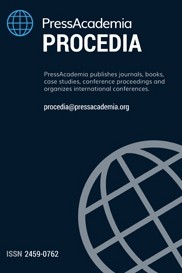THE IMPACTS OF ESTIMATION METHODS OF FINANCIAL REPORTING ON THE DECISIONS OF INVESTORS AND CONTINUITY OF BUSINESSES
Financial statements, reporting methodologies on accounting, estimations on financial statement reporting
THE IMPACTS OF ESTIMATION METHODS OF FINANCIAL REPORTING ON THE DECISIONS OF INVESTORS AND CONTINUITY OF BUSINESSES
Financial statements, reporting methodologies on accounting, estimations on financial statement reporting,
___
- Akyüz, Y. ,(2021). External balance sheets of emerging economies: low-yielding assets, high-yielding liabilities. Review of Keynesian Economics, 9(2), 232-252.
- Arya, A., Fellingham, J., Schroeder, D. (2000). Estimating transactions given balance sheets and an income statement. Issues in Accounting Education, 15(3), 393-411.
- Chychyla, R., Leone, A., Minutti-Meza, M., (2019). Complexity of financial reporting standards and accounting expertise. Journal of Accounting and Economics, 67(1), 226-253.
- Çolak, M. (2021). A new multivariate approach for assessing corporate financial risk using balance sheets. Borsa Istanbul Review, 21(3), 239-255.
- Elliott, B. and Elliott, J., (2009). Financial accounting and reporting. 13th ed. Englewood Cliffs, New Jersey: Prentice Hall.
- Handley, M., (2005). Balance sheets: tools to inform changes in practice. The Permanente Journal, 9(2), 56-65.
- Júdice, P., and Zhu, Q., (2021). Bank balance sheet risk allocation. Journal of Banking & Finance, 133, 106257.
- Kearney III, W. (2018). Case studies of financial accounting theories and techniques. Honours, University of Mississippi.
- Makrelov, K., Arndt, C., Davies, R., Harris, L. (2020). Balance sheet changes and the impact of financial sector risk-taking on fiscal multipliers. Economic Modelling, 87, 322-343.
- Sekkel, R., (2015). Balance sheets of financial intermediaries: Do they forecast economic activity? International Journal of Forecasting, 31(2), 263-275.
- Tamplin, T., (2021). Current cash debt coverage ratio. Finance Strategists. https://learn.financestrategists.com/explanation/accounting-ratios/current-cash-debt-coverage-ratio/
- Wang, M., (2017). The relationship between firm characteristics and the disclosure of sustainability reporting. Sustainability, 9(4), 624-635
- Başlangıç: 2015
- Yayıncı: PressAcademia
Feristah SONMEZ, Gultekin BAYSAL, Ismet Anik BAYSAL, Mehmet BADEMCIOGLU
CRYPTOCURRENCIES AND REGULATIONS: A COMPARATIVE FRAMEWORK FOR INTERNATIONAL IMPLEMENTATIONS
GENDER DIFFERENCES IN RISK PERCEPTION AND INVESTMENT BEHAVIOR
Dilek TEKER, Suat TEKER, Esin DEMIREL
Tulin AKDOGAN, Ibrahim AKDOGAN
DECENTRALIZED FINANCE AND NEW LENDING PROTOCOLS
Betul KAPLAN, Vahit Ferhan BENLİ, Elcin Aykac ALP
AN OVERVIEW ON KEY DIGITAL ASSETS OF DECENTRALIZED FINANCE: CRYPTOCURRENCY AND NFT
KRİPTO VARLIKLARIN YAPTIRIMLARIN ETKİSİNİ AZALTMA POTANSİYELİ VAR MIDIR?
İKTİSADİ HOŞNUTSUZLUĞUN GELİR DAĞILIMI ÜZERİNDEKİ ETKİSİ: SEÇİLİ KIRILGAN EKONOMİLER ÖRNEĞİ
